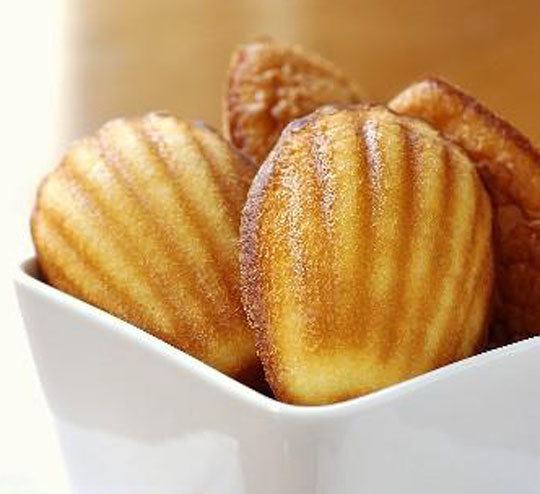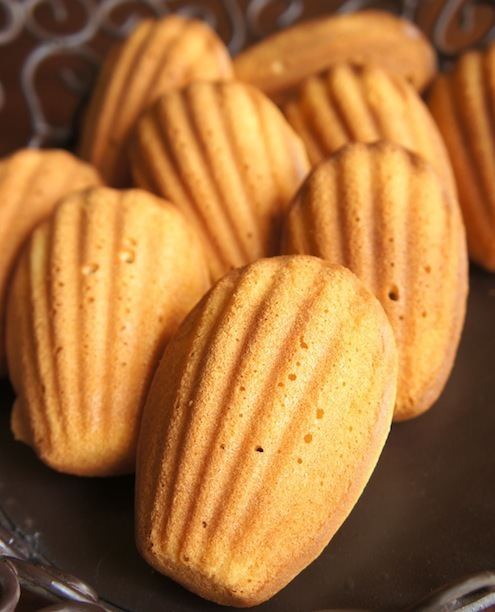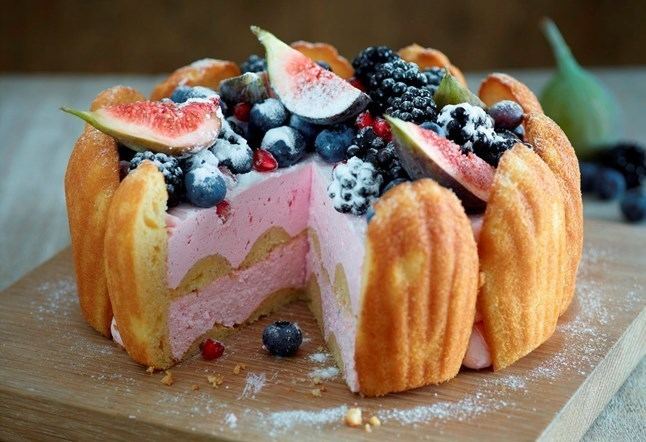Alternative names Petite madeleine | ||
 | ||
Similar | ||
The madeleine ([mad.lɛn], /ˈmædleɪn/ or /ˌmædlˈeɪn/) or petite madeleine ([pə.tit mad.lɛn]) is a traditional small cake from Commercy and Liverdun, two communes of the Lorraine region in northeastern France.
Contents

Madeleines are very small sponge cakes with a distinctive shell-like shape acquired from being baked in pans with shell-shaped depressions. Aside from the traditional moulded pan, commonly found in stores specialising in kitchen equipment and even hardware stores, no special tools are required to make madeleines.

A génoise cake batter is used. The flavour is similar to, but somewhat lighter than, sponge cake. Traditional recipes include very finely ground nuts, usually almonds. A variation uses lemon zest, for a pronounced lemony taste.

English madeleines also use a génoise sponge but they are baked in dariole moulds. After cooking, the cakes are coated in jam and desiccated coconut, and are usually topped with a glacé cherry.

Legend

Several legends are attached to the "invention" of the madeleines. They have tended to center on a female character named Madeleine who is said to have been in the service of an important character in the history of Lorraine – although there is no consensus over the last name of the cook nor the identity of the famous character. Some consider that the illustrious patron was 17th-century cardinal and rebel Paul de Gondi, who owned a castle in Commercy. Others consider that the inventor was named Madeleine Paulmier, who is said to have been a cook in the 18th century for Stanislaus I, duke of Lorraine and exiled King of Poland. The story goes that, in 1755, Louis XV, son-in-law of the duke, charmed by the little cakes prepared by Madeleine Paulmier, named them after her, while his wife, Maria Leszczyńska, introduced them soon afterward to the court in Versailles. Much beloved by the royal family, they conquered the rest of France in no time. Yet other stories have linked the cake with the pilgrimage to Compostela, in Spain: a pilgrim named Madeleine is said to have brought back the recipe from her voyage, or a cook named Madeleine is said to have offered little cakes in the shape of a shell to the pilgrims passing through Lorraine.

Other stories do not give the cake a Lorraine origin and lay its invention at the feet of pastry chef Jean Avice, who worked in the kitchens of Prince Talleyrand. Avice is said to have invented the Madeleine in the 19th century by baking little cakes in aspic moulds.
First recipes
The term madeleine to describe a small cake seems to appear for the first time in France in the middle of the 18th century. In 1758, a French retainer of an Irish Jacobite refugee in France, Lord Southwell, is said to prepare "cakes à la Madeleine and other small desserts".
The appearance of the madeleine is indicative of the increasing use of metal molds in European baking in the 18th century (see also Canelés), but the commercial success of the madeleine dates back to the early years of the 19th century. Several mentions of the madeleine are made by culinary writers during the Napoleonic era, in particular in the recipe books of Antonin Carême and by famous gastronomer Grimod de la Reynière.
In Commercy, the production at a large scale of madeleines is said to have begun in the 1760s. It is likely that the cakes were exported to Paris along with the marmalade from Bar-le-duc and the croquantes from Rheims. Batches of madeleines were often marketed in white pinewood boxes from the neighboring Vosges forest.
During the Bourbon Restoration era, the Commercy madeleines were sold in Paris for 30 centimes. Production picked up during the 1840s, and some 20,000 cakes were produced daily. The success of the madeleines of Commercy was further increased by the development of the railway, which gave the producers an easy access to the Parisian market. By the end of the 19th century, the madeleine is considered a staple of the diet of the French bourgeoisie.
The madeleine in the 20th century
Madeleines were chosen to represent France in the Café Europe initiative of the Austrian presidency of the European Union, on Europe Day 2006.
